Decla Film (originally Deutsche Eclair) was a German film production and distribution company of the silent era. Formed in 1911 as the German subsidiary of the French company Eclair, it was taken into German ownership in 1915 during the First World War. Under the direction of Erich Pommer, Decla emerged as one of the leading German film companies of the early Weimar era.
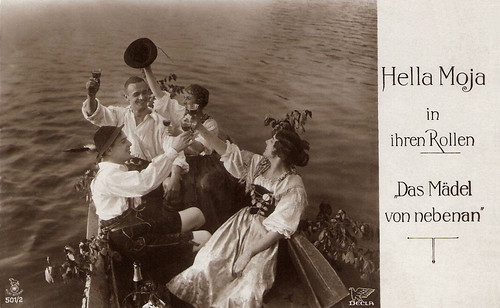
German postcard in the Film Sterne Series by Rotophot, no. 501/2. Photo: Decla. Publicity still for Das Mädel von nebenan (Otto Rippert, 1917) with Hella Moja.
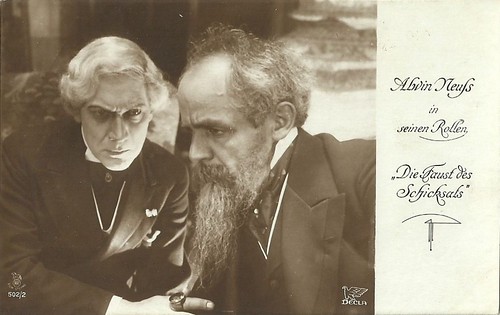
German postcard by Rotophot in the Film Sterne series, no. 502/2. Photo: Decla. Publicity still for Die Faust des Schicksals/Fist of Doom (Alwin Neuss, 1917) with Alwin Neuss.

German postcard by Rotophot in the Film-Sterne series, no. 545/5. Photo: Decla. Alwin Neuss in Der Cowboy (Alwin Neuss, 1918).
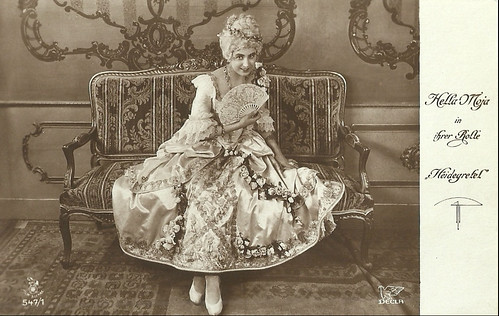
German postcard in the Film Sterne Series by Rotophot, no. 547/1. Publicity still for Heide-Gretel (Otto Rippert, 1918), with Hella Moja. Cinematography was by Carl Hoffmann, script by Carl Schneider. Moja's male co-actors were Max Ruhbeck and Leopold von Ledebur. The film premiered at the Berlin Marmorhaus cinema in February 1918.
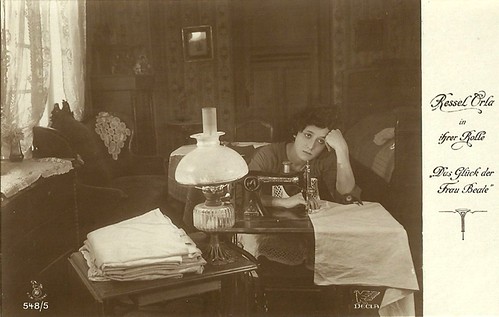
German postcard by Rotophot in the Film Sterne series, no. 548/5, 1919-1924. Photo: Decla. Publicity still for Das Glück der Frau Beate/The luck of the Mrs. Beate (Alwin Neuß, Otto Rippert, 1918) with Ressel Orla.
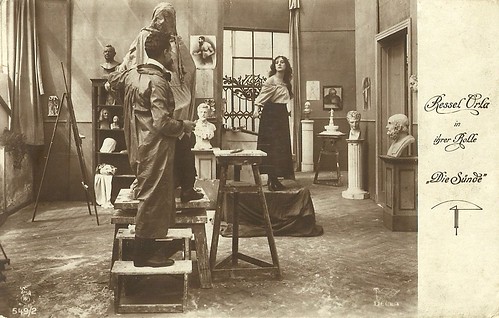
German postcard by Rotophot in the Film Sterne series, no. 549/2. Photo: Decla. Ressel Orla in Die Sünde/The Sin (Alwin Neuss, 1918).
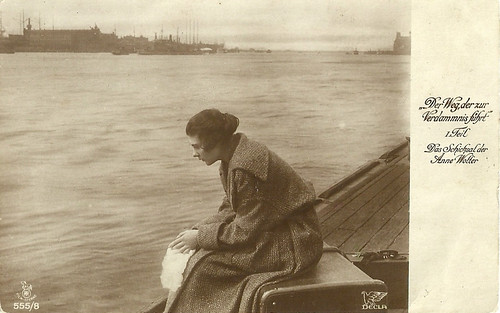
German postcard by Rotophot in the Film-Sterne series, no. 555/8. Photo: Decla. Publicity still for Der Weg, der zur Verdammnis führt, I. Das Schicksal der Änne Wolter (Otto Rippert, 1918) with Charlotte Böcklin. The name Änne Wolter is sometimes also written as Anne Wolter.
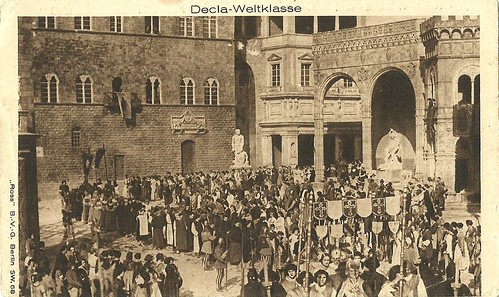
German postcard by Ross B.-V.-G., Berlin. Photo: Decla. Publicity still for the German historical drama Die Pest in Florenz/The Plague in Florence (Otto Rippert, 1919). The back of the card has a Spanish imprint.
German-born film producer and executive Erich Pommer (1889-1966) was perhaps the most powerful person in the German and European Film Industries in the 1920s and early 1930s.
As producer, Erich Pommer was involved in the German Expressionist film movement during the silent era. As the head of production at Decla Film, Decla-Bioscop and from 1924 to 1926 at Ufa, Pommer was responsible for many of the best known films of the Weimar Republic such as Das Cabinet des Dr. Caligari/The Cabinet of Dr. Caligari (Robert Wiene, 1920), Dr. Mabuse, der Spieler/Dr. Mabuse the Gambler (Fritz Lang, 1922), and Die Nibelungen (Fritz Lang, 1924).
Erich Pommer began his film career in 1907, with the Berlin branch of the Gaumont company, eventually taking over as director of its Viennese branch in 1910. In 1912, Pommer concluded his military service and became a representative of the French Éclair camera company in Vienna, where he was responsible for film distribution to Central and Eastern Europe.
In 1913, he became Éclair's general representative for Central Europe, Denmark, Sweden, Norway and Poland, based in Berlin. In the same year, he married Gertrud Levy and became, together with Marcel Vandal, the director-general of the Viennese office of Éclair. Under Pommer's direction, the company began the production of feature films.
After film, flying and the development of aviation was perhaps Pommer's greatest fascination. Pommer had made the acquaintance of and flew with Louis Blériot, the first man to fly across the English Channel. One of Pommer's first productions Das Geheimnis der Lüfte/The Mystery of the Air (1913) with Julius Brandt, had an aviation theme.
At that time, a creative producer could initiate, coordinate, supervise and control all aspects of a motion picture from inception through completion, including release. Pommer became an exemplar of the 'creative producer' and remained so throughout his career. Another five films followed in 1915. With French capital from Éclair, and together with Fritz Holz, Pommer - while serving as a soldier in 1915 at the Western front - established the Deutsche Eclair Film- und Kinematographen-GmbH (Decla) in Berlin.
Decla produced adventure and detective films, drama, and society pieces, as well as short film series. Its own Decla film distribution business, led by Hermann Saklikower, also presented foreign films. Pommer served in the First World War at the West and Eastern fronts, but injuries suffered in action led him to return to Berlin in 1916, where he was responsible for training recruits. Later, he worked for the Bild- und Filmamt (Bufa) at the German War Ministry.
During one of his trips for Bufa, going between Berlin and Bucharest, Pommer stopped over in Vienna where he was introduced to a young actor with training in art and architecture, who was interested in films. Pommer initially engaged in conversation only to be polite. However, he ended up talking with Fritz Lang the entire night, finally inviting Lang to come work for Decla after the war.

German photocard for the album Vom Werden deutscher Filmkunst. Teil I. Der stumme Film by Ross Verlag, picture no. 63. Photo: Decla-Film. Lil Dagover and Carl de Vogt in Die Spinnen/The Spiders (Fritz Lang, 1919-1920).
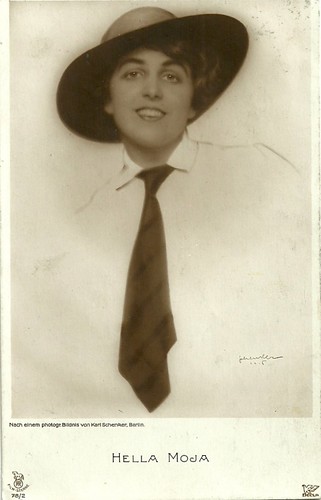
Hella Moja. German postcard by Rotophot in the Film Sterne series, no. 78/2. Photo: Karl Schenker, Berlin / Decla Film.
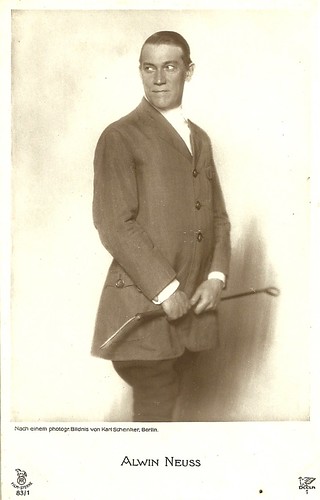
Alwin Neuss. German postcard in the Film Sterne Series by Rotophot, no. 83/1. Photo: Karl Schenker, Berlin / Decla-Film.
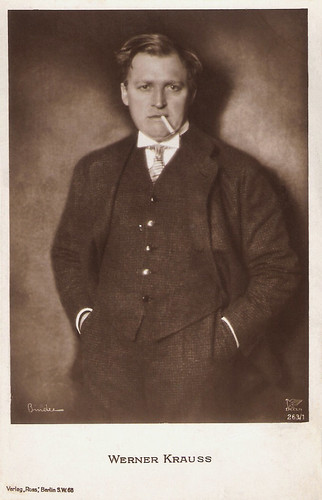
Werner Krauss. German postcard by Ross Verlag, no. 263/1, 1919-1924. Photo: Alex Binder / Decla.
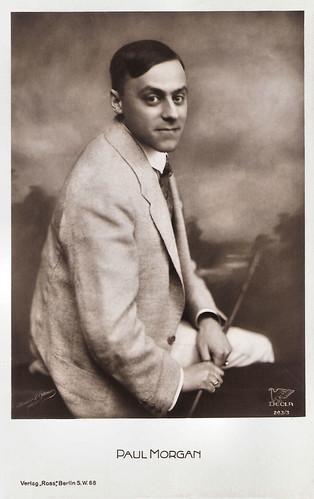
Paul Morgan. German postcard by Ross Verlag, Berlin, no. 283/3, 1919-1924. Photo: Becker & Maass / Decla.
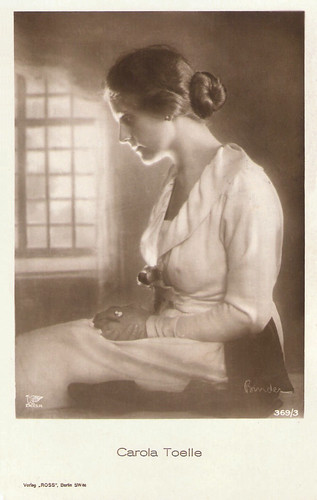
Carola Toelle. German postcard by Ross-Verlag, Berlin-Wilm., no. 369/3, 1919-1924. Photo: Alex Binder / Decla.
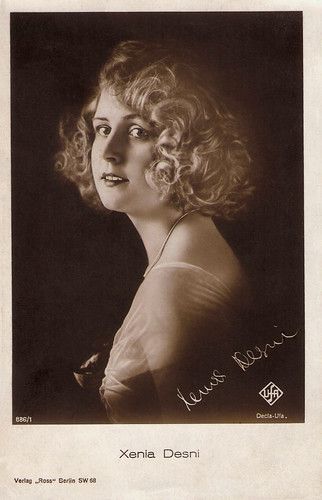
Xenia Desni. German postcard by Ross Verlag, no. 886/1, 1925-1926. Photo: Decla / Ufa. From Tatiana.
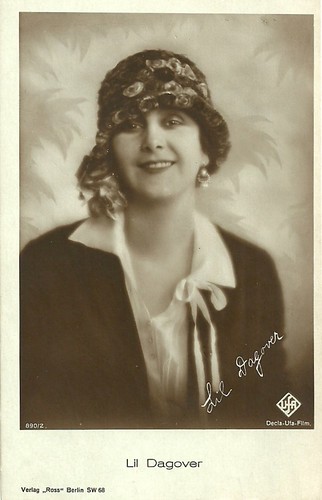
Lil Dagover. German postcard by Ross Verlag, no. 890/2, 1925-1926. Photo: Decla-Ufa-Film.
After the war, Erich Pommer assumed hands-on management of Decla. Before the war, France dominated the European film market. Soon after the war concluded, Germany's film companies faced a new competitor - Hollywood. Pommer, however, was by then an experienced film businessman with insight into the international implications of the film industry. Post-war competition between international film companies was sometimes hostile. The Berlin trade press saw Decla as the emerging leader in the industry, crediting Pommer's "very skillful and goal-oriented leadership."
Decla acquired large movie theaters through the Decla-Lichtspiel-GmbH as well as more theatres, studios and distribution channels through mergers with other companies. In 1919 Decla merged with the Meinert-Film-Gesellschaft. Decla-Film appointed Austrian screenwriter, film producer and director Rudolf Meinert to oversee production. Erich Pommer took charge of foreign distribution. Decla's production became more ambitious. Two brands were created. 'Decla Abenteuerklasse' produced among others, Fritz Lang's spy thriller Die Spinnen. 2. Teil: Die Brillantenschiff/The Spiders, Part 2: The Diamond Ship (1920). The second brand, 'Decla Weltklasse' produced such films as Das Cabinet des Dr. Caligari/The Cabinet of Dr. Caligari (Robert Wiene, 1920).
Rudolf Meinert, rather than Erich Pommer, is sometimes credited as the producer behind Decla's revolutionary Das Cabinet des Dr. Caligari/The Cabinet of Dr. Caligari (Robert Wiene, 1920). It tells the story of an insane hypnotist (Werner Krauss) who uses a somnambulist (Conrad Veidt) to commit murders. Wikipedia: "The film features a dark and striking visual style, with sharp-pointed forms, oblique and curving lines, structures and landscapes that lean and twist in unusual angles, and shadows and streaks of light painted directly onto the sets."
Now considered the quintessential work of German Expressionist cinema, Decla produced Das Cabinet des Dr. Caligari/The Cabinet of Dr. Caligari (Robert Wiene, 1920) as a low-budget horror film at their small studio in Weissensee. In fact it was filmed in the Lixie-Atelier film studio (formerly owned by Continental-Kunstfilm) at 9 Franz Joseph-Strasse (now Max Liebermannstraße), Weißensee, a north-eastern suburb of Berlin. Decla had been making films at the Lixie studio since October 1919, having previously released three titles, Die Pest in Florenz/The Plague in Florence (Otto Rippert, 1919) and the two parts of Fritz Lang's The Spiders/Die Spinnen (1919-1920). The relatively small size of the studio (built some five years earlier in 1914) meant most of the sets used in the film do not exceed six meters in width and depth. Certain elements from the original script had to be cut from the film due to the limited space.
In April 1920, Decla merged with a rival company Bioscop Film and became known as Decla-Bioscop. Bioscop had recently constructed a large, modern studio at Babelsberg in Potsdam and production was now concentrated there. Decla Bioskop AG thus became the second largest German film company after Universum Film AG (Ufa). Decla owned a studio in Neubabelsberg and a cinema chain.
Two subsidiaries were formed: Uco-Film GmbH and Russo Films. The Uco Film GmbH, in whose establishment the Ullstein publishing house was involved, dedicated itself to filming serials from novels. Schloß Vogelöd/The Haunted Castle (1921) and Phantom (1922) with Alfred Abel, both under the direction of Friedrich Wilhelm Murnau, as well as Fritz Lang's Dr. Mabuse, der Spieler/Dr. Mabuse, the Gambler (1922), were released. Russo Films focused on the adaptation of works of world literature. In a 1922 interview, Pommer stated that the international success of the German films would have to be linked to the production of quality pictures.
Pommer gathered around him talented directors (Carl Froelich and Fritz Wendhausen), script writers (Thea von Harbou, Carl Mayer, and Robert Liebmann), cameramen (Karl Freund, Carl Hoffmann, and Willy Hameister), architects (Walter Roehrig and Robert Herlth), as well as actors and actresses. In 1921, under pressure from its creditors at the Deutsche Bank, the company was absorbed into the giant Ufa concern which dominated German cinema in the interwar years. A rival, and higher offer, from National Film was rejected.
In 1922, Ufa placed Pommer in direct charge of most of its product. Pommer was also able to improve Babelsberg and made it into the largest film studio in Europe.Although Decla was now a part of Ufa, the success its films had enjoyed led to the continued use of the brand name for releases for some time. Decla maintained a modicum of independence. As late as 1924 Fritz Lang's two-part version of Die Nibelungen, Die Nibelungen: Siegfried (1924) and Die Nibelungen: Kriemhilds Rache/Die Nibelungen: Kriemhild's Revenge (1924), a big-budget prestige Ufa production, was released as a Decla-Bioscop Film.
After his glittering career at the Ufa ended in 1933, Erich Pommer worked in American exile before returning to Germany to help rebuild the German film industry after the war.

German postcard by Ross Verlag, no. 673/1. Photo: Decla / Ufa-Film. Paul Richter as Siegfried and Margarete Schön as Kriemhild in Die Nibelungen: Siegfried (Fritz Lang, 1924).
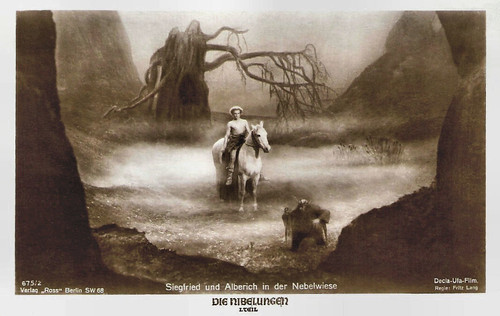
German postcard by Ross Verlag, Berlin, no. 675/2. Photo: Decla-Ufa-Film. Paul Richter in Die Nibelungen: Siegfried (Fritz Lang, 1924). Caption: Siegfried and Alberich in the fog meadow.
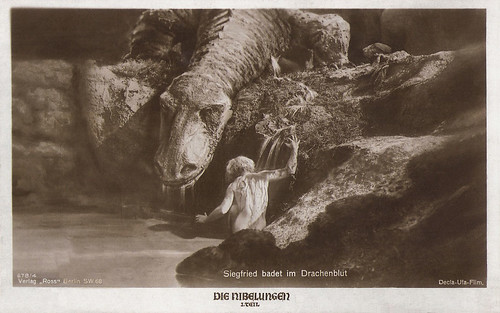
German postcard by Ross Verlag, Berlin, no. 678/4. Photo: Decla-Ufa-Film. Publicity still for Die Nibelungen: Siegfried (Fritz Lang, 1924). After slaying the dragon, Siegfried (Paul Richter) bathes in the dragon's blood, which will make him invulnerable. Incidentally, a leaf falls on his back, creating Siegfried's one weak spot (his Achilles heel). When the vain and arrogant Paul Richter refused to strip for this scene, Lang called in the not so pretty Rudolf Klein-Rogge (Etzel - Attila - in the film), who immediately undressed and played the scene, to the dismay of Richter, as people now would identify Klein-Rogge's behind as his.
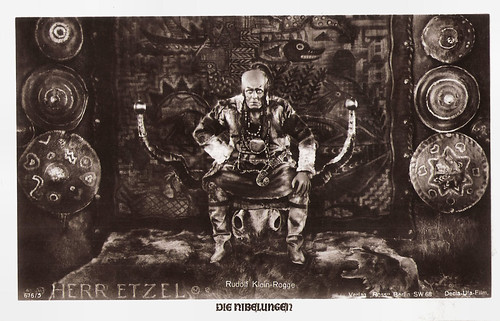
German postcard by Ross Verlag, no. 676/5. Photo: Decla-Ufa-Film. Publicity still of Rudolf Kleinn-Rogge as lord Etzel, King of the Huns, in Die Nibelungen: Kriemhilds Rache (Fritz Lang, 1924).

German postcard by Ross Verlag, Berlin, no. 677/2. Photo: Decla-Ufa-Film. Margarete Schön in Die Nibelungen: Kriemhilds Rache (Fritz Lang, 1924). Caption: Kriemhild at the spring where Siegfried died.
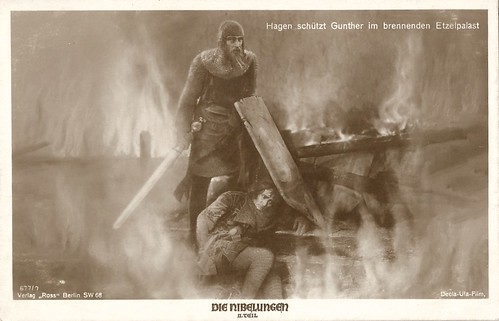
German postcard by Ross Verlag, Berlin, no. 677/7. Photo: Decla-Ufa-Film. Publicity still for Die Nibelungen: Kriemhilds Rache (Fritz Lang, 1924). Hagen von Tronje (Hans Adalbert Schlettow) protects King Gunther (Theodoor Loos) in the burning palace of Etzel.
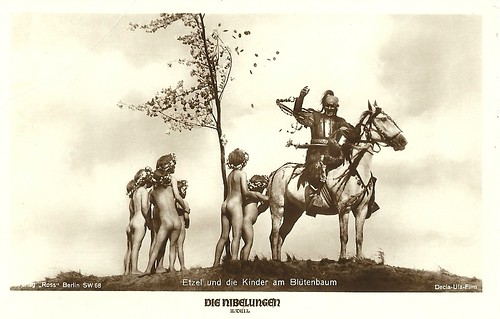
German postcard by Ross Verlag, no. Photo: Decla / Ufa-Film. Rudolf Klein-Rogge as King Etzel in part II of Die Nibelungen: Kriemhilds Rache (Fritz Lang, 1924). Caption: Etzel and the children at the blossoming tree.
Sources: John Pommer (IMDb), Wikipedia and IMDb.

German postcard in the Film Sterne Series by Rotophot, no. 501/2. Photo: Decla. Publicity still for Das Mädel von nebenan (Otto Rippert, 1917) with Hella Moja.

German postcard by Rotophot in the Film Sterne series, no. 502/2. Photo: Decla. Publicity still for Die Faust des Schicksals/Fist of Doom (Alwin Neuss, 1917) with Alwin Neuss.

German postcard by Rotophot in the Film-Sterne series, no. 545/5. Photo: Decla. Alwin Neuss in Der Cowboy (Alwin Neuss, 1918).

German postcard in the Film Sterne Series by Rotophot, no. 547/1. Publicity still for Heide-Gretel (Otto Rippert, 1918), with Hella Moja. Cinematography was by Carl Hoffmann, script by Carl Schneider. Moja's male co-actors were Max Ruhbeck and Leopold von Ledebur. The film premiered at the Berlin Marmorhaus cinema in February 1918.

German postcard by Rotophot in the Film Sterne series, no. 548/5, 1919-1924. Photo: Decla. Publicity still for Das Glück der Frau Beate/The luck of the Mrs. Beate (Alwin Neuß, Otto Rippert, 1918) with Ressel Orla.

German postcard by Rotophot in the Film Sterne series, no. 549/2. Photo: Decla. Ressel Orla in Die Sünde/The Sin (Alwin Neuss, 1918).

German postcard by Rotophot in the Film-Sterne series, no. 555/8. Photo: Decla. Publicity still for Der Weg, der zur Verdammnis führt, I. Das Schicksal der Änne Wolter (Otto Rippert, 1918) with Charlotte Böcklin. The name Änne Wolter is sometimes also written as Anne Wolter.

German postcard by Ross B.-V.-G., Berlin. Photo: Decla. Publicity still for the German historical drama Die Pest in Florenz/The Plague in Florence (Otto Rippert, 1919). The back of the card has a Spanish imprint.
Adventure and Detective films, Drama, and Society Pieces
German-born film producer and executive Erich Pommer (1889-1966) was perhaps the most powerful person in the German and European Film Industries in the 1920s and early 1930s.
As producer, Erich Pommer was involved in the German Expressionist film movement during the silent era. As the head of production at Decla Film, Decla-Bioscop and from 1924 to 1926 at Ufa, Pommer was responsible for many of the best known films of the Weimar Republic such as Das Cabinet des Dr. Caligari/The Cabinet of Dr. Caligari (Robert Wiene, 1920), Dr. Mabuse, der Spieler/Dr. Mabuse the Gambler (Fritz Lang, 1922), and Die Nibelungen (Fritz Lang, 1924).
Erich Pommer began his film career in 1907, with the Berlin branch of the Gaumont company, eventually taking over as director of its Viennese branch in 1910. In 1912, Pommer concluded his military service and became a representative of the French Éclair camera company in Vienna, where he was responsible for film distribution to Central and Eastern Europe.
In 1913, he became Éclair's general representative for Central Europe, Denmark, Sweden, Norway and Poland, based in Berlin. In the same year, he married Gertrud Levy and became, together with Marcel Vandal, the director-general of the Viennese office of Éclair. Under Pommer's direction, the company began the production of feature films.
After film, flying and the development of aviation was perhaps Pommer's greatest fascination. Pommer had made the acquaintance of and flew with Louis Blériot, the first man to fly across the English Channel. One of Pommer's first productions Das Geheimnis der Lüfte/The Mystery of the Air (1913) with Julius Brandt, had an aviation theme.
At that time, a creative producer could initiate, coordinate, supervise and control all aspects of a motion picture from inception through completion, including release. Pommer became an exemplar of the 'creative producer' and remained so throughout his career. Another five films followed in 1915. With French capital from Éclair, and together with Fritz Holz, Pommer - while serving as a soldier in 1915 at the Western front - established the Deutsche Eclair Film- und Kinematographen-GmbH (Decla) in Berlin.
Decla produced adventure and detective films, drama, and society pieces, as well as short film series. Its own Decla film distribution business, led by Hermann Saklikower, also presented foreign films. Pommer served in the First World War at the West and Eastern fronts, but injuries suffered in action led him to return to Berlin in 1916, where he was responsible for training recruits. Later, he worked for the Bild- und Filmamt (Bufa) at the German War Ministry.
During one of his trips for Bufa, going between Berlin and Bucharest, Pommer stopped over in Vienna where he was introduced to a young actor with training in art and architecture, who was interested in films. Pommer initially engaged in conversation only to be polite. However, he ended up talking with Fritz Lang the entire night, finally inviting Lang to come work for Decla after the war.

German photocard for the album Vom Werden deutscher Filmkunst. Teil I. Der stumme Film by Ross Verlag, picture no. 63. Photo: Decla-Film. Lil Dagover and Carl de Vogt in Die Spinnen/The Spiders (Fritz Lang, 1919-1920).

Hella Moja. German postcard by Rotophot in the Film Sterne series, no. 78/2. Photo: Karl Schenker, Berlin / Decla Film.

Alwin Neuss. German postcard in the Film Sterne Series by Rotophot, no. 83/1. Photo: Karl Schenker, Berlin / Decla-Film.

Werner Krauss. German postcard by Ross Verlag, no. 263/1, 1919-1924. Photo: Alex Binder / Decla.

Paul Morgan. German postcard by Ross Verlag, Berlin, no. 283/3, 1919-1924. Photo: Becker & Maass / Decla.

Carola Toelle. German postcard by Ross-Verlag, Berlin-Wilm., no. 369/3, 1919-1924. Photo: Alex Binder / Decla.

Xenia Desni. German postcard by Ross Verlag, no. 886/1, 1925-1926. Photo: Decla / Ufa. From Tatiana.

Lil Dagover. German postcard by Ross Verlag, no. 890/2, 1925-1926. Photo: Decla-Ufa-Film.
The Quintessential Work of German Expressionist Cinema
After the war, Erich Pommer assumed hands-on management of Decla. Before the war, France dominated the European film market. Soon after the war concluded, Germany's film companies faced a new competitor - Hollywood. Pommer, however, was by then an experienced film businessman with insight into the international implications of the film industry. Post-war competition between international film companies was sometimes hostile. The Berlin trade press saw Decla as the emerging leader in the industry, crediting Pommer's "very skillful and goal-oriented leadership."
Decla acquired large movie theaters through the Decla-Lichtspiel-GmbH as well as more theatres, studios and distribution channels through mergers with other companies. In 1919 Decla merged with the Meinert-Film-Gesellschaft. Decla-Film appointed Austrian screenwriter, film producer and director Rudolf Meinert to oversee production. Erich Pommer took charge of foreign distribution. Decla's production became more ambitious. Two brands were created. 'Decla Abenteuerklasse' produced among others, Fritz Lang's spy thriller Die Spinnen. 2. Teil: Die Brillantenschiff/The Spiders, Part 2: The Diamond Ship (1920). The second brand, 'Decla Weltklasse' produced such films as Das Cabinet des Dr. Caligari/The Cabinet of Dr. Caligari (Robert Wiene, 1920).
Rudolf Meinert, rather than Erich Pommer, is sometimes credited as the producer behind Decla's revolutionary Das Cabinet des Dr. Caligari/The Cabinet of Dr. Caligari (Robert Wiene, 1920). It tells the story of an insane hypnotist (Werner Krauss) who uses a somnambulist (Conrad Veidt) to commit murders. Wikipedia: "The film features a dark and striking visual style, with sharp-pointed forms, oblique and curving lines, structures and landscapes that lean and twist in unusual angles, and shadows and streaks of light painted directly onto the sets."
Now considered the quintessential work of German Expressionist cinema, Decla produced Das Cabinet des Dr. Caligari/The Cabinet of Dr. Caligari (Robert Wiene, 1920) as a low-budget horror film at their small studio in Weissensee. In fact it was filmed in the Lixie-Atelier film studio (formerly owned by Continental-Kunstfilm) at 9 Franz Joseph-Strasse (now Max Liebermannstraße), Weißensee, a north-eastern suburb of Berlin. Decla had been making films at the Lixie studio since October 1919, having previously released three titles, Die Pest in Florenz/The Plague in Florence (Otto Rippert, 1919) and the two parts of Fritz Lang's The Spiders/Die Spinnen (1919-1920). The relatively small size of the studio (built some five years earlier in 1914) meant most of the sets used in the film do not exceed six meters in width and depth. Certain elements from the original script had to be cut from the film due to the limited space.
In April 1920, Decla merged with a rival company Bioscop Film and became known as Decla-Bioscop. Bioscop had recently constructed a large, modern studio at Babelsberg in Potsdam and production was now concentrated there. Decla Bioskop AG thus became the second largest German film company after Universum Film AG (Ufa). Decla owned a studio in Neubabelsberg and a cinema chain.
Two subsidiaries were formed: Uco-Film GmbH and Russo Films. The Uco Film GmbH, in whose establishment the Ullstein publishing house was involved, dedicated itself to filming serials from novels. Schloß Vogelöd/The Haunted Castle (1921) and Phantom (1922) with Alfred Abel, both under the direction of Friedrich Wilhelm Murnau, as well as Fritz Lang's Dr. Mabuse, der Spieler/Dr. Mabuse, the Gambler (1922), were released. Russo Films focused on the adaptation of works of world literature. In a 1922 interview, Pommer stated that the international success of the German films would have to be linked to the production of quality pictures.
Pommer gathered around him talented directors (Carl Froelich and Fritz Wendhausen), script writers (Thea von Harbou, Carl Mayer, and Robert Liebmann), cameramen (Karl Freund, Carl Hoffmann, and Willy Hameister), architects (Walter Roehrig and Robert Herlth), as well as actors and actresses. In 1921, under pressure from its creditors at the Deutsche Bank, the company was absorbed into the giant Ufa concern which dominated German cinema in the interwar years. A rival, and higher offer, from National Film was rejected.
In 1922, Ufa placed Pommer in direct charge of most of its product. Pommer was also able to improve Babelsberg and made it into the largest film studio in Europe.Although Decla was now a part of Ufa, the success its films had enjoyed led to the continued use of the brand name for releases for some time. Decla maintained a modicum of independence. As late as 1924 Fritz Lang's two-part version of Die Nibelungen, Die Nibelungen: Siegfried (1924) and Die Nibelungen: Kriemhilds Rache/Die Nibelungen: Kriemhild's Revenge (1924), a big-budget prestige Ufa production, was released as a Decla-Bioscop Film.
After his glittering career at the Ufa ended in 1933, Erich Pommer worked in American exile before returning to Germany to help rebuild the German film industry after the war.

German postcard by Ross Verlag, no. 673/1. Photo: Decla / Ufa-Film. Paul Richter as Siegfried and Margarete Schön as Kriemhild in Die Nibelungen: Siegfried (Fritz Lang, 1924).

German postcard by Ross Verlag, Berlin, no. 675/2. Photo: Decla-Ufa-Film. Paul Richter in Die Nibelungen: Siegfried (Fritz Lang, 1924). Caption: Siegfried and Alberich in the fog meadow.

German postcard by Ross Verlag, Berlin, no. 678/4. Photo: Decla-Ufa-Film. Publicity still for Die Nibelungen: Siegfried (Fritz Lang, 1924). After slaying the dragon, Siegfried (Paul Richter) bathes in the dragon's blood, which will make him invulnerable. Incidentally, a leaf falls on his back, creating Siegfried's one weak spot (his Achilles heel). When the vain and arrogant Paul Richter refused to strip for this scene, Lang called in the not so pretty Rudolf Klein-Rogge (Etzel - Attila - in the film), who immediately undressed and played the scene, to the dismay of Richter, as people now would identify Klein-Rogge's behind as his.

German postcard by Ross Verlag, no. 676/5. Photo: Decla-Ufa-Film. Publicity still of Rudolf Kleinn-Rogge as lord Etzel, King of the Huns, in Die Nibelungen: Kriemhilds Rache (Fritz Lang, 1924).

German postcard by Ross Verlag, Berlin, no. 677/2. Photo: Decla-Ufa-Film. Margarete Schön in Die Nibelungen: Kriemhilds Rache (Fritz Lang, 1924). Caption: Kriemhild at the spring where Siegfried died.

German postcard by Ross Verlag, Berlin, no. 677/7. Photo: Decla-Ufa-Film. Publicity still for Die Nibelungen: Kriemhilds Rache (Fritz Lang, 1924). Hagen von Tronje (Hans Adalbert Schlettow) protects King Gunther (Theodoor Loos) in the burning palace of Etzel.

German postcard by Ross Verlag, no. Photo: Decla / Ufa-Film. Rudolf Klein-Rogge as King Etzel in part II of Die Nibelungen: Kriemhilds Rache (Fritz Lang, 1924). Caption: Etzel and the children at the blossoming tree.
Sources: John Pommer (IMDb), Wikipedia and IMDb.
No comments:
Post a Comment